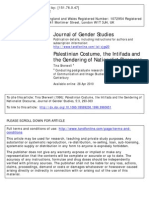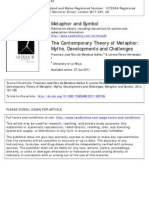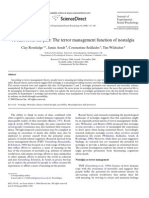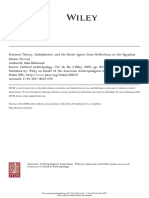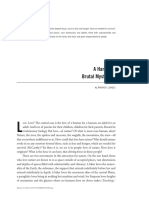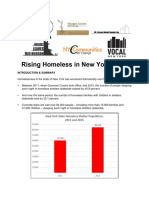Kendall Mikki Hood Feminism Notes From The Women T
Kendall Mikki Hood Feminism Notes From The Women T
Uploaded by
Liaqat BhattiCopyright:
Available Formats
Kendall Mikki Hood Feminism Notes From The Women T
Kendall Mikki Hood Feminism Notes From The Women T
Uploaded by
Liaqat BhattiOriginal Title
Copyright
Available Formats
Share this document
Did you find this document useful?
Is this content inappropriate?
Copyright:
Available Formats
Kendall Mikki Hood Feminism Notes From The Women T
Kendall Mikki Hood Feminism Notes From The Women T
Uploaded by
Liaqat BhattiCopyright:
Available Formats
Book Review/ Compte rendu
Kendall, Mikki. Hood Feminism: Notes from the Women
That a Movement Forgot. New York: Penguin Books, 2020,
pp. 258, $22.00, paper (9780525560562)
S ince its inception, the feminist movement has greatly evolved in the
scope of issues it addresses. Today, conversations about challenging
wage-gap inequalities and advancing female representation in executive
positions are at the forefront of the mainstream movement. However, in
terms of benefitting all women equally, the feminist movement still has a
long way to go. While the scope of issues addressed by the movement has
changed over time, the focal point has not. Dominated by white femin-
ism, the contemporary movement is not much different from its historical
embodiments, where the needs and perspectives of white women are pri-
oritized, and often at the expense of other marginalized groups. The title of
Mikki Kendall’s 2020 book Hood Feminism: Notes from the Women that a
Movement Forgot, embodies this sentiment.
Hood Feminism offers a critique of how the movement operates in
America today. The book argues that mainstream feminism is falling short
in the scope of people it includes, and in the breadth of issues it covers.
Because mainstream feminism centers itself largely on the needs of white
women, the movement fails to address how patriarchal forces condition the
lives of a wide range of marginalized women. For example, conversations
at the forefront of the contemporary movement center issues such as wage-
gap inequality and body hair. While these remain important issues for the
feminist agenda, Kendall highlights that these conversations are occur-
ring without regard for the women who have yet to secure basic elements
of survival, such as access to stable housing and food. Kendall dedicates
each of the 18 chapters to a specific issue where feminism is currently
failing. Some chapters focus on the shortcomings of contemporary femin-
ism’s impact on specific issues, by dissecting the discourse to identify who
is being left out of the conversation. For example, in the chapter “Black
Girls Don’t Have Eating Disorders,” Kendall delineates how eating dis-
orders experienced by those in marginalized communities, such as Black
girls, trans and non-binary folks, and people with disabilities, are often
rooted in structural factors that negatively impact identity and self-worth.
Thus, while body-positive feminism has been present in the mainstream
conversation, the impact of these structural forces is overlooked because
© Canadian Journal of Sociology/Cahiers canadiens de sociologie 47(1) 2023 87
88 © Canadian Journal of Sociology/Cahiers canadiens de sociologie 47(1) 2023
it centers on the experiences of white women. The narrow focus of the
mainstream movement’s discourse thus leaves many issues unaddressed
by feminism, such as how racism and colourism shape eating disorders
within the Black community. Other chapters, such as “Housing,” identify
areas that are currently outside the purview of the mainstream movement,
building an argument for why the issue should be regarded as a feminist
concern. With each chapter concluding with a discussion of how the move-
ment can better address the matters outlined, this book is essentially a call
to action.
Through an intersectional lens, Kendall reflexively situates herself in
the writing, enhancing the piece with accounts of her own experience as a
Black woman in America. With this, Kendall illuminates the nuanced ways
that feminism is differently understood and embraced within her commun-
ity. Kendall engages with Black feminist thought, which she characterizes
as being rooted in an understanding of how white supremacy is linked to
patriarchal ideals. Through this lens, she illuminates many cases where the
mainstream feminist movement works to uphold white supremacy and to
reinforce the privilege that white women have over their racialized female
and male counterparts. Throughout the book, Kendall challenges the nar-
row boundaries of white mainstream feminism and pays homage to the
many Black women before her who championed victories for women’s
equality, but who are largely forgotten by history.
In the introductory chapter, Kendall explains how feminism has al-
ways existed in her community, albeit differently than how it is understood
by white women. She tells the story of her grandmother, who despite being
a feminist role model for Kendall, would have never identified with a fem-
inist label. This is because as a Black woman who grew up in the Jim Crow
era, the feminist movement was not one that included her. In the ensuing
discussion, Kendall provides an in-depth analysis of how and why femin-
ism operates differently in the Black community, and other communities
of color. For example, Kendall reflects on how the stringent gender roles
that she faced as a little girl and the toxic masculinity that is seemingly
present in gang culture have shaped her own interpretation of feminism.
Within the mainstream movement however, white feminists have lever-
aged these experiences and community dynamics against Black women
to question the authenticity and integrity of the Black feminist agenda. It
is this failure of the mainstream movement to understand the complexities
that race, class, and history have on marginalized communities that work
to exclude women of colour in particular, from the feminist movement.
Kendall addresses these biases by highlighting the pervasive impact
of white supremacy on communities of colour. For example, rigid gender
roles are embedded in the conservative values that many marginalized
Hood Feminism: Notes from the Women That a Movement Forgot 89
residents historically embraced in hopes of providing their children with
better opportunities. Similarly, toxic masculinity has been shaped by the
war on drugs and ensuing mass incarceration. Cultivated by what she re-
fers to as a “twisted method of self-defence” (2020: 80), Kendall explains
that Black men resort to this bravado in their communities to insulate them
from the harms in the broader world. This explanation does not, however,
excuse the reproduction of toxic culture derived from white supremacy
in smaller communities like her own. Although these issues are likewise
present in communities with higher socioeconomic standing, Kendall con-
tends that they have a unique dynamic in communities of color, and thus
must be solved internally. Kendall maintains that patriarchal structures can
be dismantled and replaced only through a comprehensive understanding
of the patriarchy, which acknowledges the history, violence, and trauma
that marginalized girls and women face. This theme of change from within
is woven throughout the book. In many chapters, Kendall emphasises the
importance of treating those currently left out of the movement as self-de-
termining agents. She also highlights that these individuals must be at the
forefront of conversations about how issues concerning their communities
are to be addressed. Here, Kendall draws a boundary for these commun-
ities. She clarifies that white feminists have no place addressing any issues
on behalf of communities to which they do not belong unless specifically
invited. In chapters concerning other shortcomings of the movement, Ken-
dall pinpoints where white feminists need to step up and use their privilege
to advocate for all women and reduce the harm done to others.
A core strength of this book is the positionality that Kendall offers
and how the discussions extend beyond her own racial and middle-class
locations to highlight how the movement leaves out a myriad of identities.
In each chapter, Kendall discusses how the focal issue differently impacts
other communities of color, the disabled community, LGBTQIA individ-
uals, and a long list of others who are ignored by white mainstream femin-
ism. She often approaches these issues intersectionally, considering how
individuals marginalized by multiple identities are presented with unique
challenges at their intersection. At the same time, Kendall never claims
to understand nor know how to best solve the problems experienced by
groups that are different from her own. She highlights the importance of
this approach within discussions across various chapters that clarify how
the White saviour mentality of many proponents in the mainstream move-
ment rarely helps resolve any issues and, in many cases, ends up further
marginalizing the very groups that white women are claiming to protect.
Kendall explains how accusations of being divisive have followed
those who criticized the movement for leaving out certain groups. How-
ever, Kendall rejects this, because the alternative of doing nothing means
90 © Canadian Journal of Sociology/Cahiers canadiens de sociologie 47(1) 2023
accepting that feminism can operate in ways that are antithetical to its
supposed goals of equality for all. With Kendall citing examples of how
mainstream feminism has been co-opted by white conservative women
in politics to push anti-choice legislation, or by white female voters to
defend electing President Donald Trump, the pitfalls of this movement
as it stands today could not be clearer. Hood Feminism is written in the
American context, but the structural forces driving the issues discussed
are similarly present in Canada. Therefore, Kendall’s advice and action-
able steps are equally applicable to Canadian readers. With the breadth of
topics covered and identities included, scholars at both the undergraduate
and graduate level studying inequalities and intersectionality may be espe-
cially interested in Hood Feminism. The blend of personal experience and
theory in Kendall’s writing bridges the gap between the shortcomings of
the movement and how it can improve. She offers a clear directive on how
conversations can be constructed to push the movement forward. Because
of this, Hood Feminism is also useful for organizational leaders seeking to
inform their workplace policies with diverse perspectives. Whether it is a
call to action to do work in your community (or stay out of the work being
done in other communities), how to include diverse voices, how to lend
your privilege to the benefit of others, or how to act in solidarity for other
women, Kendall offers advice and clear, actionable steps for readers look-
ing to make the feminist movement more inclusive.
For readers in the academy and business world alike, Hood Feminism
is for those looking to have their own diverse experiences discussed and
recognized in feminist discourse, and for white readers seeking to confront
their privilege and to learn how to perform better allyship. This book is
a refreshing take that identifies the limitations of the feminist movement
without diminishing the various ways women in marginalized commun-
ities embrace feminist thought and use it as a tool for self-determination.
With a piece for all identities, Hood Feminism highlights the work that
must be done in solidarity by all feminists to make the movement one that
reflects diverse backgrounds and that works to the benefit of all.
Western University Miranda McDonald
Miranda McDonald is a MA student in the department of Sociology at Western
University. She received a bachelor’s degree in Management and Organizational
Studies at Western University in 2020. The focus of her master›s research is on
how social media shapes and informs the political ideologies of young voters,
and her research interests more broadly include education, Marxist theory, and
social inequalities.
Email: mmcdo22@uwo.ca
You might also like
- Peace and Human Rights: Concepts & Issues: Bernardo E. Guillermo Iii, MpaDocument56 pagesPeace and Human Rights: Concepts & Issues: Bernardo E. Guillermo Iii, MpaJoylyn Cabbab Verzon - Armiendo100% (2)
- (Evelyn Fox Keller) Reflections On Gender and Scie (BookFi)Document201 pages(Evelyn Fox Keller) Reflections On Gender and Scie (BookFi)Fernando GonzalezNo ratings yet
- Analyzing Oppression - Cudd, Ann E., 1959 - 2006 - New York - Oxford University Press - 9780195187434 - Anna's ArchiveDocument300 pagesAnalyzing Oppression - Cudd, Ann E., 1959 - 2006 - New York - Oxford University Press - 9780195187434 - Anna's Archiveratyanshgarg2005100% (1)
- BRADWAY, FREEMAN. Queer Race, Kinship Sex, Belonging, FormDocument360 pagesBRADWAY, FREEMAN. Queer Race, Kinship Sex, Belonging, FormHaroldo LimaNo ratings yet
- Juda Bennett - Toni Morrison and The Burden of The Passing NarrativeDocument14 pagesJuda Bennett - Toni Morrison and The Burden of The Passing NarrativeIncógnitaNo ratings yet
- Mediation Statement 1 BlawDocument3 pagesMediation Statement 1 Blawapi-383594707No ratings yet
- "Hum 6, or Reading Before Theory" by Richard PoirierDocument6 pages"Hum 6, or Reading Before Theory" by Richard PoirierBarton FalstaffNo ratings yet
- Beautiful Bottom, Beautiful Shame Where "Black" Meets "Queer" by Kathryn Bond StocktonDocument267 pagesBeautiful Bottom, Beautiful Shame Where "Black" Meets "Queer" by Kathryn Bond Stocktonruby faureNo ratings yet
- Foss Genreric Criticism - JPG PDFDocument5 pagesFoss Genreric Criticism - JPG PDFsmall_chicken_9xNo ratings yet
- Sara Ahmed, Lancaster University: Communities That Feel: Intensity, Difference and AttachmentDocument15 pagesSara Ahmed, Lancaster University: Communities That Feel: Intensity, Difference and AttachmentClaire BriegelNo ratings yet
- Marshall Mcluhan The Mechanical Bride in The Mechanical Bride Folklore of Industrial Man 1951Document4 pagesMarshall Mcluhan The Mechanical Bride in The Mechanical Bride Folklore of Industrial Man 1951654321No ratings yet
- In The Combat ZoneDocument5 pagesIn The Combat ZoneJason MowerNo ratings yet
- Journal of Gender StudiesDocument12 pagesJournal of Gender StudiesmatteoBRNo ratings yet
- Franco Moretti - The Way of The World - The Bildungsroman in European Culture (2000, Verso)Document260 pagesFranco Moretti - The Way of The World - The Bildungsroman in European Culture (2000, Verso)Míša SteklNo ratings yet
- Letter TemplateDocument1 pageLetter Templateapi-300153278No ratings yet
- A Reading of Love in HölderlinDocument16 pagesA Reading of Love in HölderlinDwight SchrootNo ratings yet
- Orientations Toward Death: A Vital Aspect of The Study of Lives by Edwin S. Shneidman 1963Document28 pagesOrientations Toward Death: A Vital Aspect of The Study of Lives by Edwin S. Shneidman 1963jhobegiNo ratings yet
- Abstract MetaphorDocument26 pagesAbstract Metaphorralukanikoleta100% (1)
- Pedestrian Theory Syllabus FINAL Feb 2 2016Document4 pagesPedestrian Theory Syllabus FINAL Feb 2 2016Aylin KarayiğitNo ratings yet
- 265538eng PDFDocument398 pages265538eng PDFAllMoravideNo ratings yet
- Walking and Talking Feminist Rhetorics: Landmark Essays and ControversiesFrom EverandWalking and Talking Feminist Rhetorics: Landmark Essays and ControversiesNo ratings yet
- Catharine R. Stimpson - 'Zero Degree Deviancy - The Lesbian Novel in English', Critical Inquiry, 8 (2), 'Writing and Sexual Difference', 1981 PDFDocument18 pagesCatharine R. Stimpson - 'Zero Degree Deviancy - The Lesbian Novel in English', Critical Inquiry, 8 (2), 'Writing and Sexual Difference', 1981 PDFscottbrodie100% (1)
- The Benefit of Farting BOOK ExcerptDocument19 pagesThe Benefit of Farting BOOK Excerptbookworm0003No ratings yet
- Source 04Document186 pagesSource 04Hager AhmedNo ratings yet
- Unmournable Bodies - The New Yorker Teju ColeDocument4 pagesUnmournable Bodies - The New Yorker Teju ColeGaby ArguedasNo ratings yet
- Audre Lorde Discussion Questions and QuestionnaireDocument2 pagesAudre Lorde Discussion Questions and QuestionnaireSean Dirt AnderssonNo ratings yet
- R01 - Routledge 2008 - A Blast From The Past. The Terror Management Function of NostalgiaDocument9 pagesR01 - Routledge 2008 - A Blast From The Past. The Terror Management Function of NostalgiaGrupa5No ratings yet
- Ellen Rooney and Elizabeth Weed D I F F e R e N C e S in The Shadows of The Digital HumanitiesDocument173 pagesEllen Rooney and Elizabeth Weed D I F F e R e N C e S in The Shadows of The Digital HumanitiesLove KindstrandNo ratings yet
- Feminism and Decostruction. Mary PooveyDocument16 pagesFeminism and Decostruction. Mary PooveyIrene ArchiniNo ratings yet
- Bel and The DragonDocument13 pagesBel and The DragonWerdy WotNo ratings yet
- Punctuations: The Time of A Thesis: Installati NDocument11 pagesPunctuations: The Time of A Thesis: Installati NhorsfaceNo ratings yet
- Jean Baudrillard, Utopia Achieved, America, 75-105 (Re-Scan) PDFDocument21 pagesJean Baudrillard, Utopia Achieved, America, 75-105 (Re-Scan) PDFbernarda LoraNo ratings yet
- Identity Politics and The Need For A Tomorrow': Gurminder K Bhambr A, Victoria MargreeDocument8 pagesIdentity Politics and The Need For A Tomorrow': Gurminder K Bhambr A, Victoria MargreeJohn O'sheaNo ratings yet
- The Literary Theory and Criticism of Henry Blake Fuller - Jeffrey Swanson DissertationDocument218 pagesThe Literary Theory and Criticism of Henry Blake Fuller - Jeffrey Swanson Dissertationmswanson8757No ratings yet
- Gentle Introductions To LacanDocument4 pagesGentle Introductions To LacanJoseVegaNo ratings yet
- 06 CHolland, Readingand Identitya Psychoanalytic RevolutionDocument4 pages06 CHolland, Readingand Identitya Psychoanalytic RevolutionabiiktkNo ratings yet
- RT Witt OpeningDocument2 pagesRT Witt OpeningB Rhie100% (1)
- New Depthiness PDFDocument12 pagesNew Depthiness PDFLuis LaroccaNo ratings yet
- Bhabha - of Mimicry and ManDocument10 pagesBhabha - of Mimicry and MankdiemanueleNo ratings yet
- Mahmood, Saba Feminist Theory, Embodiment, and The Docile Agent Some Reflections On The Egyptian Islamic RevivalDocument36 pagesMahmood, Saba Feminist Theory, Embodiment, and The Docile Agent Some Reflections On The Egyptian Islamic RevivalSofia Carbajal100% (1)
- Carrier y Bryson - Looking at The Overlooked. Four EssaysDocument4 pagesCarrier y Bryson - Looking at The Overlooked. Four EssaysLuciaNo ratings yet
- Theater of The Forgotten Modern Greek Prison Islands - Van - Steen PDFDocument62 pagesTheater of The Forgotten Modern Greek Prison Islands - Van - Steen PDFAntiKleptocratNo ratings yet
- Ever After Postmemory Fairy Tales and The Body in Second Generation Memoirs by Jewish WomenDocument18 pagesEver After Postmemory Fairy Tales and The Body in Second Generation Memoirs by Jewish WomenHouda BoursNo ratings yet
- UntitledDocument322 pagesUntitledMarta Peris FerriNo ratings yet
- Said and Political Theory - Jeanne More EldDocument17 pagesSaid and Political Theory - Jeanne More EldMarcos Lampert VarnieriNo ratings yet
- HopscotchDocument300 pagesHopscotchRosa MariaNo ratings yet
- Eliminate Racism Concept PaperDocument30 pagesEliminate Racism Concept PaperDaniel M100% (1)
- Get God The Failed Hypothesis How Science Shows That God Does Not Exist Victor J. Stenger PDF Ebook With Full Chapters NowDocument70 pagesGet God The Failed Hypothesis How Science Shows That God Does Not Exist Victor J. Stenger PDF Ebook With Full Chapters Nowmiochcatama69100% (10)
- Brightman - Grateful Prey - Rock Cree Human-Animal RelationshipsDocument308 pagesBrightman - Grateful Prey - Rock Cree Human-Animal Relationshipsvarnamala100% (1)
- The University of Chicago PressDocument6 pagesThe University of Chicago PressMartin CothranNo ratings yet
- Across Gender Across SexualityDocument12 pagesAcross Gender Across SexualityRuqiyya Qayyum100% (1)
- Melancholia and Anthropology: University of CambridgeDocument17 pagesMelancholia and Anthropology: University of CambridgeArturo EsquivelNo ratings yet
- Jacques Derrida - of SpiritDocument19 pagesJacques Derrida - of SpiritsanchezmeladoNo ratings yet
- LOVE Art Politics Adrienne Rich InterviewsDocument10 pagesLOVE Art Politics Adrienne Rich Interviewsmadequal2658No ratings yet
- Charles E. Scott - Words, Silence, Experiences - Derrida's Unheimlich Responsibility PDFDocument20 pagesCharles E. Scott - Words, Silence, Experiences - Derrida's Unheimlich Responsibility PDFManticora VenerabilisNo ratings yet
- Location Matters The Rhetoric of Place in Protest, Endres Senda Cook 2001Document27 pagesLocation Matters The Rhetoric of Place in Protest, Endres Senda Cook 2001ferNo ratings yet
- 傅柯性史 03 the History of Sexuality by Michel Foucault 傅柯:性史Document4 pages傅柯性史 03 the History of Sexuality by Michel Foucault 傅柯:性史Chun-hsiung ChenNo ratings yet
- Clifford Writing CultureDocument161 pagesClifford Writing CultureMaria Martha SarmientoNo ratings yet
- Umberto Eco On ListsDocument4 pagesUmberto Eco On ListskuseteNo ratings yet
- Alphonso Lingis - A Hard and Brutal MysticismDocument8 pagesAlphonso Lingis - A Hard and Brutal MysticismTavarishNo ratings yet
- Giorgio Agamben Friendship 1 PDFDocument6 pagesGiorgio Agamben Friendship 1 PDFcamilobeNo ratings yet
- Guy Hocquenghem - Destroy SexualityDocument4 pagesGuy Hocquenghem - Destroy SexualityMax StirnerNo ratings yet
- Envisioning Eden: Mobilizing Imaginaries in Tourism and BeyondFrom EverandEnvisioning Eden: Mobilizing Imaginaries in Tourism and BeyondNo ratings yet
- TraditionalBirth NorthernThailand Midwifery 2005Document16 pagesTraditionalBirth NorthernThailand Midwifery 2005Liaqat BhattiNo ratings yet
- Lecture-Systematic Review of LitertureDocument48 pagesLecture-Systematic Review of LitertureLiaqat BhattiNo ratings yet
- 2-Research Design - Aug 2021Document18 pages2-Research Design - Aug 2021Liaqat BhattiNo ratings yet
- The Mughal Empire and British Raj A Captivating Guide To The History of India, Starting From The Mughals To The British Empire by Captivating History (History, Captivating)Document183 pagesThe Mughal Empire and British Raj A Captivating Guide To The History of India, Starting From The Mughals To The British Empire by Captivating History (History, Captivating)Liaqat BhattiNo ratings yet
- Princess or Heroine - A Qualitative Analysis On How The Portrayal of FemaleDocument132 pagesPrincess or Heroine - A Qualitative Analysis On How The Portrayal of FemaleLiaqat BhattiNo ratings yet
- Traditional Gender Roles - The Culture of Toxic Masculinity and THDocument140 pagesTraditional Gender Roles - The Culture of Toxic Masculinity and THLiaqat BhattiNo ratings yet
- The Impact of Social Media On Consumer BehaviourDocument66 pagesThe Impact of Social Media On Consumer BehaviourLiaqat Bhatti0% (1)
- Akram Chun.Document8 pagesAkram Chun.Liaqat BhattiNo ratings yet
- Before The Senior Member, Board of Revenue, Punjab, LahoreDocument14 pagesBefore The Senior Member, Board of Revenue, Punjab, LahoreLiaqat BhattiNo ratings yet
- Education Emergency A Social X RayDocument2 pagesEducation Emergency A Social X Rayfarahhabib9122000No ratings yet
- NALSA Vs UOI PresentationDocument6 pagesNALSA Vs UOI PresentationPrerika100% (1)
- Written Report DRRRDocument3 pagesWritten Report DRRRFrances GeonzonNo ratings yet
- Impact of Child Labor in The Society-Group 1.editedDocument4 pagesImpact of Child Labor in The Society-Group 1.editedRAEJEHL TIMCANGNo ratings yet
- 7.1 WorksheetsDocument4 pages7.1 WorksheetsEmily FernandezNo ratings yet
- VELASCO, Sharmaine J. HREDocument3 pagesVELASCO, Sharmaine J. HRESharmaine Javinar VelascoNo ratings yet
- Mms Geographies Overview National Medical and Pharmacy 202201 212534 1689848522Document30 pagesMms Geographies Overview National Medical and Pharmacy 202201 212534 1689848522Manish SinghNo ratings yet
- Brgy VAW Desk OrdinanceDocument8 pagesBrgy VAW Desk OrdinanceCatherine ParinasNo ratings yet
- Rising Homeless in New York State 2016Document20 pagesRising Homeless in New York State 2016VOCAL-NYNo ratings yet
- Political and Legal Perspective in Gender and SexualityDocument13 pagesPolitical and Legal Perspective in Gender and SexualityKim Stephen T. Francisco100% (1)
- Article 1-3 of The Philippine Constitution by Hector de LeonDocument7 pagesArticle 1-3 of The Philippine Constitution by Hector de LeonShawntyl Fay Silva100% (2)
- DEMOCRATIC RIGHTS Questions and AnswersDocument4 pagesDEMOCRATIC RIGHTS Questions and Answersathangsurvase16No ratings yet
- Research CyberlibelDocument2 pagesResearch CyberlibelMa. Cheriña DionisioNo ratings yet
- Walmart Case Study - Preliminary Examination - Ocampo GPDocument7 pagesWalmart Case Study - Preliminary Examination - Ocampo GPgabriel ocampoNo ratings yet
- FEA III - Propuesta de Exámen Final - Rios SandraDocument10 pagesFEA III - Propuesta de Exámen Final - Rios SandraSandra RiosNo ratings yet
- Nari O Shishu Nirjatan Daman Ain, 2000 Prevention of Oppression Against Women and Children Act, 2000 Amended 2020Document12 pagesNari O Shishu Nirjatan Daman Ain, 2000 Prevention of Oppression Against Women and Children Act, 2000 Amended 2020islamiclife639100% (1)
- Is Colombia OverpopulatedDocument3 pagesIs Colombia OverpopulatedSharit Gineth Cuta MartínezNo ratings yet
- EthicsDocument2 pagesEthicsAngelica Faye LitonjuaNo ratings yet
- TDH Italy Whistleblowing Policy EnglishDocument5 pagesTDH Italy Whistleblowing Policy EnglishJ.A.B.ANo ratings yet
- Sex TraffickingDocument13 pagesSex Traffickingapi-296031932No ratings yet
- Excerpt From Southern Horrors Lynch Laws in All Its PhasesDocument9 pagesExcerpt From Southern Horrors Lynch Laws in All Its PhasesJAKE FAMNo ratings yet
- Ethics Activity 01Document2 pagesEthics Activity 01Ronna EncinasNo ratings yet
- Practice Test Unit 9Document5 pagesPractice Test Unit 9Trà Dương PhươngNo ratings yet
- Ba0200057 M Yasodha Sem III Criminal Liability of Juvenile OffendersDocument20 pagesBa0200057 M Yasodha Sem III Criminal Liability of Juvenile OffendersYasodha MothilalNo ratings yet
- The War On Drugs SP2011Document180 pagesThe War On Drugs SP2011Sanjay MallipudiNo ratings yet
- Waste Food ManagementDocument2 pagesWaste Food Managementjoycebasan269No ratings yet
- Mariemar Villaroza ResearchDocument4 pagesMariemar Villaroza ResearchRhie VillarozaNo ratings yet












